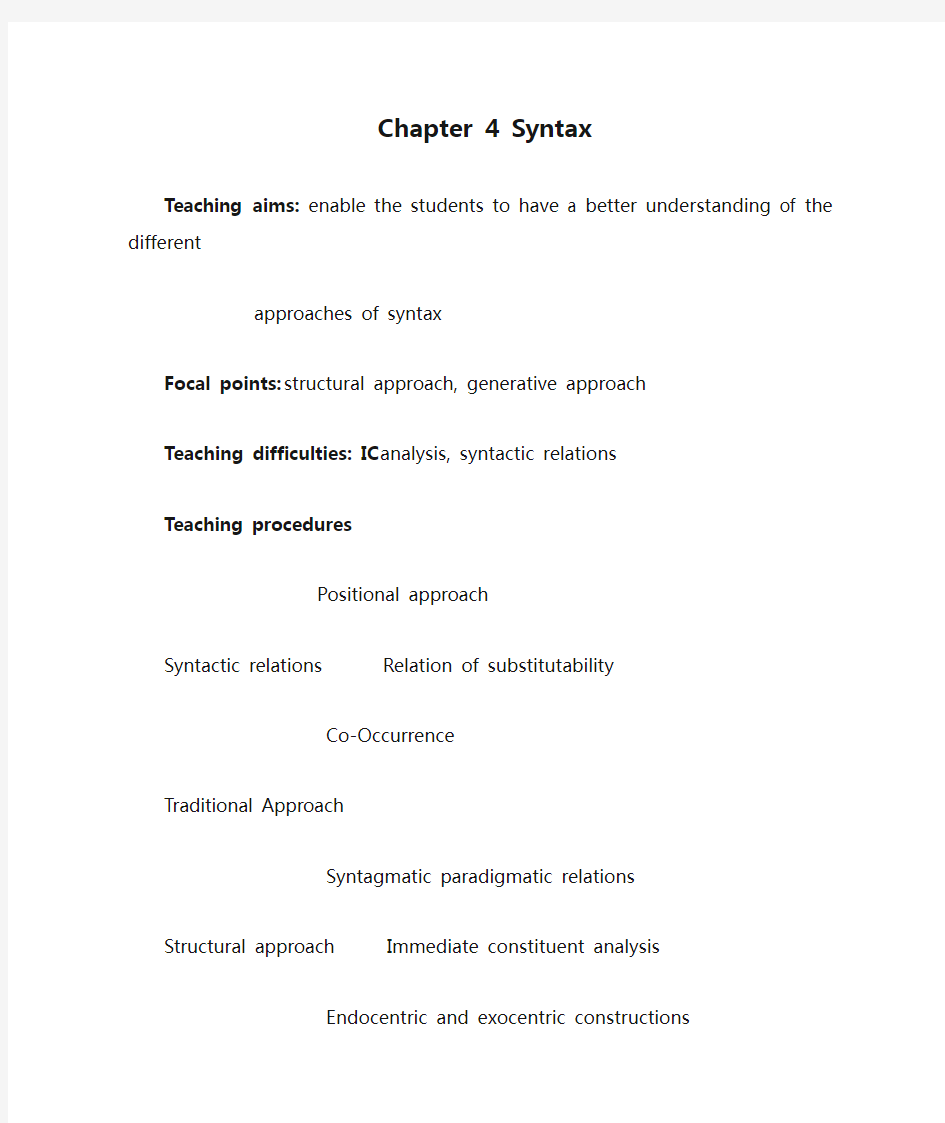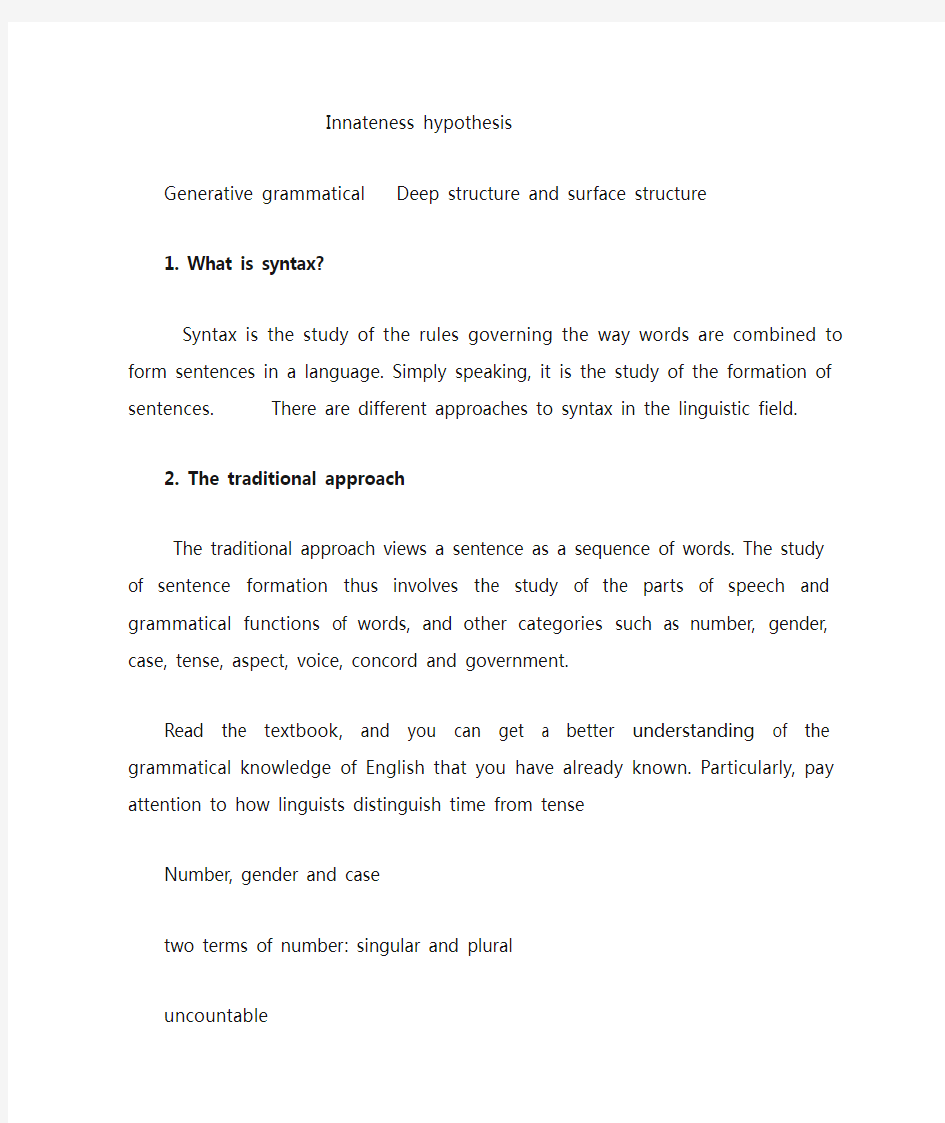

Chapter 4 Syntax
Teaching aims: enable the students to have a better understanding of the different approaches of syntax
Focal points: structural approach, generative approach
Teaching difficulties: IC analysis, syntactic relations
Teaching procedures
Positional approach
Syntactic relations Relation of substitutability
Co-Occurrence
Traditional Approach
Syntagmatic paradigmatic relations
Structural approach Immediate constituent analysis
Endocentric and exocentric constructions
Innateness hypothesis
Generative grammatical Deep structure and surface structure
1. What is syntax?
Syntax is the study of the rules governing the way words are combined to form sentences in a language. Simply speaking, it is the study of the formation of sentences. There are different approaches to syntax in the linguistic field.
2. The traditional approach
The traditional approach views a sentence as a sequence of words. The study of sentence formation thus involves the study of the parts of speech and grammatical functions of words, and other categories such as number, gender, case, tense, aspect, voice, concord and government.
Read the textbook, and you can get a better understanding of the grammatical knowledge of English that you have already known. Particularly, pay attention to how linguists distinguish time from tense
Number, gender and case
two terms of number: singular and plural
uncountable
noun countable singular – He speaks Italy. (verbal inflection)
plural – books, men, mice, data, sheep, potatoes, they, etc. Number gender and case
two terms of gender: male and female
actor, hero, prince, lion, god, man, policeman, men workers, male elephant, he-goat, etc.
actress, heroine, princess, lioness, goddess, woman, policewoman, woman worker, female elephant, she-goat, etc.five terms of case: nominative (主格), accusative (宾格), genitive (属格), dative (与格) and ablative (离格)
I, she (nominative); me, her (accusative); my, your, his, John’s, boy’s (genitive)
You (nominative) lent a book (accusative) to me (dative) and the book (nominative) was lost, so I gave you (accusative) a pen in return. You wrote a letter with the pen (ablative).
Tense and aspect
Aspect shows the type of act and whether the act continues or not.
There are 16 tenses in English but only two (past and present) are recognized. Actions to take place in future time could be expressed in many tenses.
Perfective and imperfective:
We have planted 5000 trees since the year 2000. (imperfective)
I have worked here for 10 years. (imperfective)
He has finished his homework. (perfective)
category (范畴)
Concord and government(一致与支配)
Concord & agreement – the forms of two or more words in a syntactic relationship should agree with each other in terms of some categories.
e.g. this man, these men; a book, some books
He speaks Chinese and they speak English.
Everyone should take good care of his own business.
3.The structural approach
This approach was started by the Swiss linguist Ferdinand de Saussure, the father of modern linguistics, in the beginning of the 20th century. All the linguistic theories after Saussure are structural in that they all regard linguistic units as interrelated with each other in a structure (or system), not as isolated bits.
Only one of Saussure’s main idea and the American structuralist model of sentence analysis are talked about here.
3.1 Syntagmatic and paradigmatic relations
3.1.1 Defining the two relations
In Saussure’s view, language is a system of signs (i.e. words), and the value of each individual sign must be explained from its relations to others, or its position in the system. The two principle types of relations which Saussure identified are syntagmatic and paradigmatic relations.
The syntagmatic relation (组合关系), nowadays also referred to as the horizontal relation or the chain relation, is the relation between one item ant others in a linear sequence, or between elements which are all present.
The paradigmatic relation (聚合关系), nowadays also referred to as the vertical relation or the choice relation, is a relation holding between elements replaceable with each other at a particular place in a structure, or between one element present and the others absent.
3.2 Immediate constituent analysis
3.2.1 What is immediate constituent analysis?
Immediate constituent analysis, often shortened as IC Analysis, is an approach to the analysis of sentence structures. The following notions are essential to the full understanding of it.
3.2.1.1 Constituent
The component elements of a construction, i.e. a linguistic form or group of linguistic forms, are called its constituents. For example, John’s, mother, left,
yesterday, John’s mother, and left yesterday are all constituents of the sentence John’s mother left yesterday.
3.2.1.2 Binary cutting
In analyzing a construction, a common practice is to cut it into two parts and then cut each of the two parts into two and continue with this segmentation until we reach the smallest grammatical unit, the morpheme. This practice is called binary cutting.
(illustration with a tree diagram, see P123, 125)
3.2.1.3 Immediate constituent
Immediate constituents refer to the constituents immediately, directly, below the level of a construction. For example, John’s mother and left yesterday are the immediate constituents of the sente nce John’s mother left yesterday, while John’s and mother are the immediate constituents of John’s mother, and John and -’s are the immediate constituents of John’s.
3.3 Endocentric and exocentric constructions
3.3.1 Endocentric constructions (内向结构)
An endocentric construction is one whose distribution is functionally equivalent, or approaching equivalence, to one of its constituents, which serves as the centre, or head, of the whole. Hence an endocentric construction is known as a headed construction (中心结构).
Endocentric constructions may be further divided into two subtypes: SUBORDINATE and COORDINATE constructions.
Those in which there is only one head, with the head being dominant and the other constituents dependent, are subordinate constructions (从属结构), for example, pretty girls.
Coordinate constructions (并列结构)are those in which there are more than one head, e.g. boys and girls, in which the two content constituents, boys and girls, are of equal syntactic status, and no one is dependent on the other. In other words, both are capable of serving as the head.
3.3.2 Exocentric constructions
The exocentric construction(外向结构)is defined as a construction whose distribution is not functionally equivalent to any of its constituents. There is no noticeable centre, or head, in it. Prepositional phrases and subordinate clauses are typical examples of this type.
3.2.1.4 Ultimate constituent
Ultimate constituents refer to the smallest grammatical unit in a construction, obtained through binary cuttings.
So far, we can give a definition-like statement about IC Analysis: IC Analysis refers to the approach to divide a construction up into its immediate constituents by using binary cuttings until obtaining its ultimate constituents.
3.2.2 Its advantages and problems (P124-29)
It is important and helpful to know that IC Analysis helps to analyze some structural ambiguities. Read the textbook and pay attention to how logical and dialectical analyses of things are made.
3.1.2 Two important notions: structure and system (P122)
The sequence which a sign forms with others, with which it is in a syntagmatic relation, is called a structure by some linguists.
The class of signs which are in a paradigmatic relation are referred to as a system by some linguists.
4.1 The innateness hypothesis (P434)
Chomsky believes that language is somewhat innate, and that children are born with what he calls a LANGUAGE ACQUISITION DEVICE.
Chomsky’s hypothesis is based on his observations that some important fa cts can never be otherwise explained adequately.
Language or Linguistic universals (P436-37)
Competence and performance
4.2 What is a generative grammar? (P437-)
A system of rules that in some explicit and well-defined way assigns structural descriptions to sentences
A means to explore the universal rules in the hope of revealing human cognitive systems
A linguist’s work is to discover a universal grammar from particular grammars. (P438)
Chomsky’s idea of an adequate grammar (P439-40)
Read the textbook, and you can get a better understanding of the grammatical knowledge of English that you have already known.
4.3 The transformational component of TG grammar
Surface structure vs deep structure and implications of the distinction (P132, 438) Transformational rules (P133, 441-43)
4.4 Main features of TG Grammar (P452)
deductive methodology (P438)
Questions and Exercises
1. In what ways is IC Analysis better than traditional parsing? (P124)
2. In employing IC Analysis, how do we know where to make the cuts? (P123-24)
3. Comment on this idea: If nobody is there to teach a child to speak, he can never have the ability to talk. (P434-35)